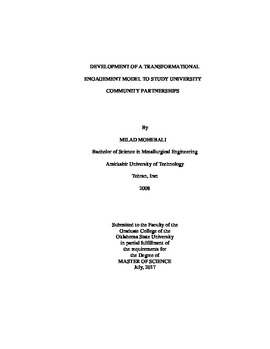| dc.description.abstract | Mutuality of benefits and reciprocity are the characteristics of university community engagement partnerships that render them democratic and enable universities to serve a larger purpose in working with communities. A review of literature shows that 1- mutually beneficial and reciprocal partnerships are not always the case in practice, 2- the terms lack conceptual clarity, and 3- the literature provides varied and at times contradictory evidence on how to develop such partnerships. By bringing the university community engagement literature in conversation with the Social Exchange tradition, particularly, Social Commitments Theory and Reciprocity Theory, through a critical interpretive synthesis approach, this study develops a new model to study university community engagement and partnerships. Transformational Engagement Model (TEM) provides a clear definition for mutuality of benefits and reciprocity, suggests that reciprocity can be developed from mutually beneficial partnerships through a transformational process, and provides recommendations on how to facilitate formation of transformational partnerships. By framing reciprocity as an outcome of transformational partnerships, TEM criticizes the current direction in institutionalizing engagement through training individuals to do the counter-normative work. TEM suggests that intentionality from institutions should be directed toward encouraging formation of transformational partnerships. TEM also criticizes portraying mutually beneficial partnerships as selfish, and reciprocal partnerships as selfless and non-utilitarian. Rather, TEM suggests that reciprocal partnerships have to be mutually beneficial and universities can have self-interest in engaging with communities. Finally, TEM provides recommendation on how to form structures that may facilitate formation of transformational partnerships. First, partnerships should be designed in ways that the relationships between individuals could be sustained for long periods. Second, different task types that incorporate different engagement structures are encouraged. Third, tasks need to be interdependent and groups, and not individuals, should be kept accountable for the partnership outcomes. Finally, engagement structures allow analysis of sophisticated engagement structures and investigation of formation of reciprocity among groups and beyond dyadic relationships. I also argue that TEM’s conceptualization of reciprocity is more aligned with the Deweyan conception of learning by doing that the university community engagement advocates. | |
